Welcome to our Colossus Movie Guide for The Dark Knight. This guide contains everything you need to understand the film. Dive into our detailed library of content, covering key aspects of the movie. We encourage your comments to help us create the best possible guide. Thank you!
What is The Dark Knight about?
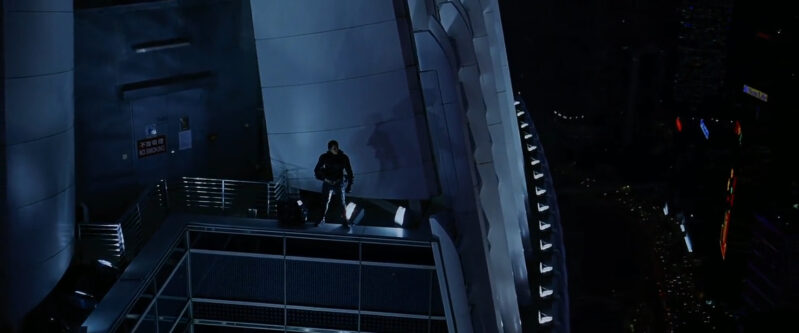
The Dark Knight deftly navigates the tumultuous waters of morality and the elusive nature of justice. Its narrative isn’t merely a tale of a heroic caped vigilante battling a psychopathic villain, but a profound exploration of the duality of human nature and the thin line that separates order from chaos. The movie propels us into a world where the concepts of good and evil are not painted in clear blacks and whites but are steeped in varying shades of grey, forcing us to question our own perceptions of right and wrong.
The movie delves into the often precarious balance between power and corruption, challenging our conventional definitions of heroism. Through the eponymous Dark Knight, the movie shows how the burden of power often forces individuals into a moral gray area. In contrast, the Joker’s anarchic philosophy confronts us with the uncomfortable possibility that the pillars of our society—order, morality, and sanity—are merely elaborate illusions vulnerable to collapse. The Dark Knight ultimately illustrates how fragile our societal structures can be when faced with the antithesis of everything we hold to be just and moral. The stark cityscape of Gotham, under siege, becomes a metaphor for our own struggles with morality and justice, making the movie a timeless reflection of the human condition.
Movie Guide table of contents
Cast
- Christian Bale – Bruce Wayne / Batman
- Michael Caine – Alfred Pennyworth
- Heath Ledger – the Joker
- Gary Oldman – James Gordon
- Aaron Eckhart – Harvey Dent / Two-Face
- Maggie Gyllenhaal – Rachel Dawes
- Morgan Freeman – Lucius Fox
- Jonathan Nolan – Writer
- Christoper Nolan – Director and writer
The ending of The Dark Knight explained
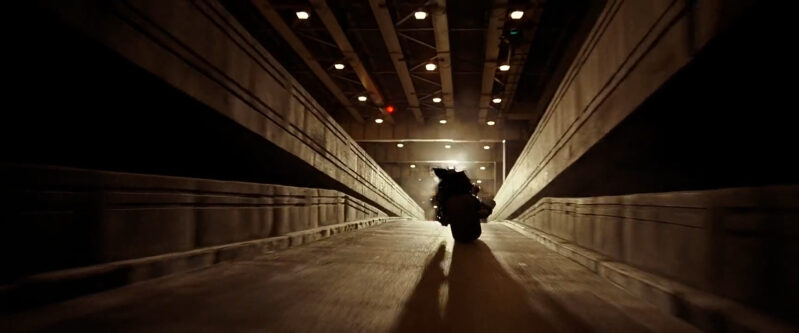
A recap of The Dark Knight‘s ending
In the final act of The Dark Knight, Coleman Reese, an accountant at Wayne Enterprises, unravels the secret of Batman’s identity and attempts to bring this information to light. However, in a terrifying twist, the Joker threatens to detonate a hospital unless Reese is assassinated, plunging the city into a state of heightened panic.
As the police force scrambles to evacuate all city hospitals and Commissioner Gordon tries desperately to keep Reese safe, the Joker exploits Harvey Dent’s despair. He meets with Dent, who is disillusioned and grief-stricken after losing Rachel, and nudges him to seek personal vengeance outside the confines of the law. Dent, now bearing the persona of Two-Face, succumbs to the Joker’s persuasion, turning his half-charred coin into an instrument of fate. He proceeds to execute those he deems responsible for Rachel’s demise—the corrupt law enforcement officers and members of the mafia.
Amidst the ensuing pandemonium, the Joker discloses his latest dreadful plot: two evacuation ferries—one ferrying civilians, the other transporting prisoners—are wired to explode at the stroke of midnight. The catch is that each group has the power to save themselves by triggering the explosion on the other ferry. But to the Joker’s astonishment, despite their fear, the passengers on both ferries refuse to annihilate each other. Batman then subdues the Joker, choosing not to take his life. As the police move in to apprehend the Joker, he taunts Batman with the revelation that his scheme to corrupt Harvey Dent has indeed succeeded.
The climax unfolds as Harvey Dent, now transformed into Two-Face, takes Commissioner Gordon’s family hostage, attributing Rachel’s death to Gordon’s negligence. As he flips his coin to decide their fates, Batman intervenes, tackling Dent to save Gordon’s son. The confrontation results in Dent falling to his death. In a significant turn of events, Batman elects to shoulder the blame for Dent’s actions and death, understanding that Dent’s image as a hero is essential for Gotham’s morale. He convinces Gordon to keep the truth hidden. Alfred, in a moment of discretion, burns a letter from Rachel meant for Wayne, which revealed her choice of Dent over Wayne. Lucius Fox, respecting Wayne’s previous instructions, destroys the extensive surveillance system Batman had used to locate the Joker.
In the aftermath, Gotham City mourns the loss of Dent, lionizing him as a hero. Meanwhile, Batman, bearing the burden of Dent’s crimes, becomes the object of a citywide manhunt, disappearing into the obscurity of the night as the Dark Knight.
The meaning of The Dark Knight‘s ending
First, let’s review all the pieces of this ending and how they speak to the movie’s most important themes. Then we’ll conclude by tying all that information together and evaluating the ultimate message and meaning of The Dark Knight.
Reese’s blackmail
Coleman Reese’s decision not to expose Batman’s true identity represents the film’s exploration of identity and the notion of greater good. His understanding that Batman, though a vigilante, is a necessary entity for Gotham’s fight against crime reveals an awareness of the duality that the city exists in. His choice to remain silent despite the personal gain he could achieve reinforces the movie’s theme of personal sacrifice for communal benefit. It also highlights the dichotomy between private identity and public perception, as Bruce Wayne’s dual identities are crucial for the restoration of order in Gotham.
Harvey Dent’s transformation
Harvey Dent’s transformation into Two-Face, driven by the Joker’s persuasive speech, encapsulates the struggle between order and chaos. The Joker’s argument that the world is inherently disorderly and arbitrary resonates with Dent, leading him down a path of chaos and reprisal. This metamorphosis provides an intimate look into the impact of chaos on an individual’s morality and sense of justice. It resonates with the theme of duality, showing how one man can embody both order (as Dent) and chaos (as Two-Face).
The Joker’s terrorist plot
The Joker’s failed ferry scheme is a powerful reflection of humanity’s capacity to uphold moral values even amidst extreme fear and chaos. Contrary to the Joker’s expectations, the civilians and prisoners alike choose not to detonate the other ferry, thus refusing to descend into chaos. This defiance embodies the film’s central conflict between chaos and order, underlining the inherent human ability to uphold morality under duress. It also challenges the Joker’s belief in the pervasive corruptibility of humanity.
Two-Face’s coin
Two-Face’s coin, an emblem of chance and randomness, symbolizes the inherent unpredictability and impartiality of life, further underscoring the theme of chaos. It also becomes a twisted representation of Dent’s moral compass, which has been skewed by the chaotic events in his life. The coin flip reflects how Dent’s once clear-cut perception of justice is now left to randomness, an allegory for his descent into chaotic vengeance.
Batman shoulders the blame
Batman’s decision to assume responsibility for Harvey’s crimes speaks volumes about the film’s themes of sacrifice and moral ambiguity. Batman understands the need for a symbol of hope and order, hence his decision to preserve Dent’s image as Gotham’s White Knight. His choice emphasizes the often blurred line between heroism and villainy, demonstrating that doing the right thing often involves personal sacrifices and, sometimes, becoming the “villain.”
Burning the letter
Alfred’s decision to burn Rachel’s letter signifies the movie’s exploration of painful truths and their potential for destruction. He recognizes the potential harm the truth could inflict on Bruce and his mission as Batman, underlining the film’s theme of necessary deceptions for the greater good. It parallels Batman’s decision to keep the truth of Dent’s downfall hidden, reinforcing the necessity of maintaining hope even in the face of bitter truth.
Destroying the surveillance system
Lastly, Lucius Fox’s decision to destroy the surveillance system demonstrates the film’s nuanced commentary on the boundaries of justice. While the system helped Batman locate the Joker, Fox understands its potential for misuse and violation of privacy. His action resonates with the theme of moral boundaries and the ethical concerns inherent in the pursuit of justice.
In Conclusion
In essence, the ending of The Dark Knight offers a wealth of insights into the film’s deeper themes and meanings. Each character’s choices, shaped by their experiences and moral compasses, contribute to a comprehensive exploration of duality, chaos and order, fear and courage, and the moral sacrifices necessary for the greater good. It prompts viewers to reflect on the complexities of morality, the fine line between heroism and villainy, and the ceaseless struggle between chaos and order. This confrontation with these realities underscores the profoundness of the narrative and its enduring relevance.
Reese’s choice, for example, forces us to consider the larger implications of truth and the potential damage it can inflict when untimely revealed. His decision underscores the delicate balance between individual freedom and collective responsibility, invoking reflections on our own choices and their impact on our communities.
Harvey Dent’s fall from grace, catalyzed by the Joker’s nihilistic perspectives, echoes our society’s struggle against disruptive forces that seek to destabilize order. His subsequent transformation into Two-Face and reliance on his coin highlights the sometimes arbitrary and unpredictable nature of justice, especially when it’s left to the whims of a disillusioned individual.
The Joker’s unsuccessful plot with the ferries attests to the resilience of human spirit and the inherent desire for order, even when faced with self-preserving temptiness. It serves as a powerful counter-narrative to his belief in humanity’s corruptibility, stressing the innate goodness that can emerge even in the most dire circumstances.
Batman’s decision to take the blame for Harvey’s actions presents a nuanced perspective on the concept of heroism. It emphasizes that true heroes often operate in the shadows, making difficult choices and sacrifices, and that heroism isn’t always about public adoration but about ensuring the preservation of hope, even if it means becoming a perceived villain.
Alfred’s act of burning Rachel’s letter and Lucius’s dismantling of the surveillance system both indicate an understanding of the potential harm that truth and power, if misused, can inflict. They reinforce the need for discretion and ethical considerations in our pursuits, highlighting the complex interplay of truth, secrecy, power, and morality.
In conclusion, the ending of The Dark Knight serves as a poignant climax to the film’s exploration of these complex themes. It invites audiences to delve deeper into the intricacies of morality, justice, and chaos, urging them to question their own understanding of these concepts. Through a careful analysis of the ending, we can appreciate the movie’s remarkable depth and its enduring commentary on the human condition.
The themes and meaning of The Dark Knight

Duality and Identity
One of the most salient themes in The Dark Knight is the exploration of duality and identity. The film delves into this concept through its protagonist, Batman, and his villainous counterpart, the Joker. The duality of Batman’s identity is manifested in his life as Bruce Wayne, the wealthy philanthropist, and his alter-ego, Batman, the vigilante. His struggle to balance these two identities reveals a critical exploration of personal identity versus social roles.
Batman, the embodiment of justice and order, is often seen grappling with the morally questionable decisions he has to make to maintain peace in Gotham. He conceals his true identity to bear the burden of these decisions, implying that societal roles may sometimes necessitate us to suppress our genuine selves. This duality echoes the broader societal dichotomy between who we are and who we are expected to be.
On the other hand, the Joker represents a disturbing kind of duality. Unlike Batman, he has no secret identity. His anarchic philosophy and unpredictable behavior reveal a darker side of human nature. The Joker’s identity is built around chaos and destruction, and he revels in the carnage he creates. His character suggests that chaos and order, good and evil, are dual aspects of humanity, and it’s our choices that determine which side prevails.
The philosophical exploration of duality traces back to ancient thinkers like Plato and Aristotle and continues with modern theorists such as Carl Jung. Jung’s concept of “the shadow” emphasizes the co-existence of contrasting elements within the individual psyche, a notion that echoes the duality depicted in The Dark Knight. The duality in Batman—Bruce Wayne versus his alter ego—epitomizes this internal struggle between our real and ideal selves.
In terms of societal identity, sociologist Peter L. Berger’s work offers insight. He posits that societal identity is a complex, ongoing negotiation, often fraught with conflicts due to the plurality of individual identities and societal norms. Gotham City, with its diverse citizens from varying backgrounds, exemplifies this struggle for cohesive societal identity. The divergence between Batman’s vigilante justice and the formal legal system underlines the tensions that arise when individual actions challenge collective societal norms.
Chaos and Order
The juxtaposition of chaos and order is another central theme in The Dark Knight. Gotham City serves as the backdrop where this epic battle between these opposing forces unfolds. The Joker, as an agent of chaos, is fixated on disrupting the established order, revealing the fragility of societal structures when faced with unpredictable and anarchic threats.
The Joker’s actions throughout the film, from his carefully orchestrated bank heist to the bombing of the hospital, continually destabilize Gotham’s societal order. His schemes force characters into morally compromising positions, showcasing how the veneer of order can swiftly dissolve into chaos under extreme circumstances.
In stark contrast, Batman represents the force of order, continually striving to restore peace and stability in Gotham. Despite the moral ambiguities he must navigate, his actions underscore the necessity for order in preserving societal structures and protecting innocent lives. Batman’s struggle to maintain order amidst chaos mirrors our own societal battles against disruptive forces.
Historically, societies have continually battled against disruptive forces threatening their order. For instance, the socio-political upheaval during the 1960s in the United States, marked by civil rights movements, anti-war protests, and counter-cultural revolution, significantly tested societal order. Law enforcement agencies, like Batman in the film, often found themselves in morally complex situations, tasked with maintaining order while also addressing genuine societal grievances.
Batman’s conflict with the Joker mirrors this broader societal struggle. The Joker’s relentless chaos-testing of Gotham’s moral fabric parallels the way disruptive forces can cause societal unrest. Just as Batman navigates these challenges, societies must also grapple with maintaining order amidst chaos while addressing the root causes of such disruption.
Fear and Courage
Fear and courage operate as two intertwined themes in The Dark Knight. Fear, as a manipulative tool, is extensively exploited by both heroes and villains in the film. Batman utilizes fear to intimidate criminals, while the Joker uses it to create havoc. This dual usage of fear underscores its inherent power and how it can be harnessed for both constructive and destructive purposes.
Conversely, courage is depicted as a critical virtue required to confront and overcome fear. Throughout the movie, Batman, and even ordinary citizens of Gotham, display remarkable bravery in the face of extreme danger and uncertainty. Harvey Dent’s assertion, “I believe in Harvey Dent,” is not just a campaign slogan but a bold proclamation of self-belief and courage, even though his character later undergoes a tragic transformation.
The ferry scene towards the film’s climax encapsulates the struggle between fear and courage. Both ferries, filled with Gotham’s citizens and criminals, are given the power to annihilate the other to save themselves. Despite their fear, the passengers choose not to succumb to the Joker’s terror, displaying exceptional courage. This scene underscores the film’s assertion that courage is the ultimate antidote to fear and a crucial element in the pursuit of justice and order.
Harvey Dent’s character arc in The Dark Knight adds another complex layer to the theme of fear and courage. At the onset, Dent represents the embodiment of courage and hope for Gotham. He stands tall as the city’s “White Knight,” relying on the judicial system rather than resorting to Batman’s vigilante methods.
However, the Joker masterfully manipulates Dent’s fear and despair following the tragic death of Rachel, causing Dent’s courage and faith in justice to falter. His transformation into Two-Face symbolizes a catastrophic descent into fear and vengeance, marking a stark contrast from his former persona. Dent’s fall underscores the potency of fear and its capacity to undermine even the most courageous and principled individuals.
Dent’s use of a coin to decide the fate of his victims also speaks to this theme. The coin flip introduces a terrifying unpredictability that instills fear, while the courage to face the outcome is left to his victims, further emphasizing the Joker’s chaotic manipulation of fear and its consequences.
In the end, Batman chooses to shoulder the blame for Dent’s crimes to preserve the image of courage and hope that Dent once represented, demonstrating a profound act of courage. This decision maintains the citizens’ faith in justice and order, emphasizing that while fear can indeed corrupt, courage and hope can still triumph.
Why is the movie called The Dark Knight?
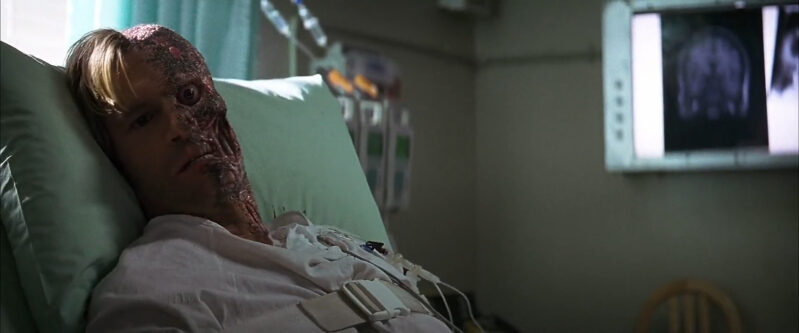
The Dark Knight isn’t simply an identifier for the movie’s protagonist, Batman. Rather, it serves as a complex metaphor that encases the entirety of the film’s narrative within its confines. It encapsulates the thematic heart of the film: the exploration of moral ambiguity, the struggle with internal darkness, and the implications of a hero operating outside the bounds of traditional law.
“Dark” symbolizes the inherent philosophical complexity and the inevitable ambiguity that comes with wielding power. Throughout the film, Batman is forced to navigate this ethical maze, often pushed into ethically dubious actions in his quest for justice. This darkness doesn’t only refer to the character’s persona or his literal dark attire, but to the shadowy nuances of his morality. It invites us to consider the blurred boundaries between right and wrong, and to question whether the ends can truly justify the means.
The “Knight” represents the classical archetype of a warrior bound by a code of chivalry, serving as a protector of the realm. Yet, in Batman’s case, this chivalry isn’t as straightforward. While he is the self-appointed protector of Gotham, he operates outside the law, often making decisions that local law enforcement and governing bodies cannot or will not make. His “knighthood” thus reflects a vigilante justice, not sanctioned by any authority, but rather necessitated by the circumstances. This aspect of the title provokes thoughts about the nature of lawfulness and how it should be upheld when traditional systems fail.
The combination of these two words, “Dark” and “Knight,” indicates the blending of these two complicated ideas. The titular Dark Knight is a figure who grapples with his own darkness and principled ambiguity while attempting to uphold fairness in an often corrupt and chaotic world. The title prompts us to consider the ethical complications involved when someone takes the law into their own hands, even with the best of intentions.
The title’s significance also extends beyond the character of Batman. It indirectly refers to the city of Gotham and its citizens. Gotham, like its vigilante, is a “Dark Knight” in its own right. The city is plagued by crime, corruption, and a sense of despair, representing societal structures that grapple with similar moral complexities. The citizens of Gotham, who harbor both fear and admiration for Batman, become complicit in his vigilantism, thereby reflecting their own struggle with darkness and the thirst for justice.
Important motifs in The Dark Knight
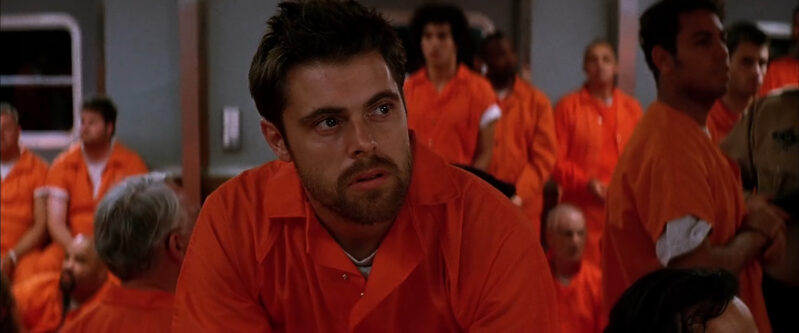
Masks
In The Dark Knight, the motif of masks serves as a potent symbol of dual identities and the divide between public personas and private selves. The most obvious manifestation of this is Batman’s cowl, which Bruce Wayne dons to keep his vigilante activities separate from his billionaire playboy identity. This mask not only conceals his true identity but also creates a symbol that the citizens of Gotham can rally behind.
Yet, it’s not just Batman who wears a mask. The Joker’s painted face is his own kind of mask, hiding his true nature and making his actions unpredictable. Even Harvey Dent, before his transformation into Two-Face, can be seen as wearing a metaphorical mask, with his charismatic and heroic public image hiding his inner turmoil and capacity for vengeance. The recurring motif of masks in the film explores the complexity of identities, particularly in a society teeming with corruption and chaos.
The Joker’s Cards
The Joker’s cards are a recurring motif that embodies the themes of chaos and unpredictability. In the film, the Joker often leaves a Joker card at the scene of his crimes, signalling his presence and instilling fear. The cards represent the Joker’s chaotic nature, symbolizing the randomness and unpredictability of his actions.
However, the cards also represent a perverted sense of order. Just like each card in a deck has a specific role in the rules of a card game, the Joker has a particular role in the grand scheme of his chaos. His card motif becomes an ironic representation of his belief in chaos, showing that even within disorder, there is a twisted sense of order, an ideology that the Joker embraces wholeheartedly.
The Bat Signal
The Bat Signal is a significant motif throughout the film that signifies hope and the pursuit of justice. A beacon that lights up Gotham’s sky, it represents the city’s call for help and Batman’s responsibility to respond. Despite the darkness and corruption prevalent in Gotham, the Bat Signal is a constant reminder that there’s a force fighting for order and justice.
The motif of the Bat Signal also touches on the theme of symbols in the film. Batman becomes more than a man—he becomes a symbol embodied by the Bat Signal. This allows Batman to inspire hope in Gotham’s citizens, showing that symbols can have the power to effect change and stand against disorder.
Two-Face’s Coin
Two-Face’s coin is a prominent motif that represents the theme of chance and the duality of mankind. The coin, which is regular at first, becomes scarred on one side after the explosion that disfigures Harvey Dent, effectively turning it into a two-faced coin. It symbolizes the duality of Dent’s character and the idea that good and evil reside within everyone.
Moreover, the coin becomes Two-Face’s instrument of justice, deciding the fate of his victims based on a flip. This reliance on chance mirrors the unpredictability and impartiality of life, reinforcing the film’s theme of chaos. Yet, the coin also represents a skewed sense of order in Dent’s mind, underscoring the blurred line between order and chaos that the film explores.
The Ferries
The two ferries in the film’s climax, one carrying civilians and the other carrying prisoners, serve as a crucial motif that encapsulates the struggle between order and chaos, and the inherent goodness of humanity. The Joker’s deadly game forces the passengers on each ferry to decide whether to detonate the other ferry to save themselves.
Despite the Joker’s belief that people will resort to savagery when pushed to the edge, the passengers on both ferries refuse to kill the other group. This represents a collective victory for order and morality over chaos and self-preservation, contradicting the Joker’s worldview. This motif echoes the film’s broader themes, reinforcing the idea that even in the face of fear and potential destruction, individuals can uphold moral values and choose the path of order over chaos. It challenges the Joker’s cynical perception of humanity, revealing an inherent decency and capacity for selflessness even under extreme circumstances.
Questions & answers about The Dark Knight
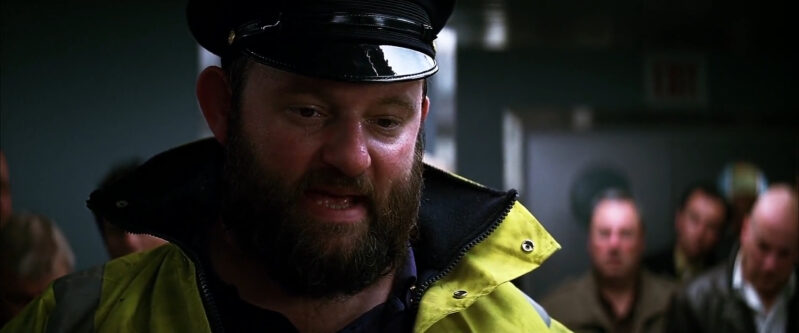
Why did Maroni betray Joker?
Salvatore Maroni, the mafia boss, initially collaborated with the Joker to kill Batman, who was a threat to their criminal activities. However, as the Joker’s chaotic and unpredictable actions started causing immense destruction in Gotham, Maroni began to question their alliance. The Joker’s actions were not only causing trouble for Batman and the city’s administration, but also destabilizing the established order within the criminal world that Maroni and his cohorts thrived on.
When the Joker goes so far as to blow up a hospital and implement the ferry bomb scheme, Maroni realizes that the Joker’s chaos is uncontrollable and threatens his own interests. It is this reckoning that leads him to give up the Joker’s location to Harvey Dent. This decision echoes one of the film’s core themes: the struggle between order and chaos. Even among criminals, there is a desire for order and predictability, something the Joker vehemently disrupts. Understanding Maroni’s betrayal of the Joker adds to the film’s exploration of this theme and emphasizes how chaos can unsettle both legal and illegal structures of power.
Why did Joker want Reese dead?
Coleman Reese is an accountant for Wayne Enterprises who discovers Batman’s true identity and plans to reveal it to the public. The Joker, interested in maintaining chaos and disruption, realizes that Batman’s identity becoming public could end Batman’s career, thereby removing a key element of disorder in the city.
Joker’s decision to target Reese and incite others to kill him is a twisted game to further spread fear and chaos, consistent with his anarchic nature. His desire to keep Batman’s identity secret is not out of alliance but rather to ensure his fun continues. The Joker’s motive is, once again, steeped in chaos, and his manipulation of others to achieve his ends demonstrates the film’s exploration of corruption and how fear can be used to control and influence.
Why didn’t Reese expose Batman’s identity?
Coleman Reese, despite knowing Batman’s identity, ultimately decides not to expose him. This is not due to any altruistic motive, but rather due to a combination of self-preservation and the realization of Batman’s importance to Gotham’s fight against crime. When Reese attempts to reveal the secret on a television show, the Joker intervenes, threatening to blow up a hospital unless someone kills Reese. The Joker’s threat forces Reese to reconsider, as his life becomes endangered.
Moreover, during this ordeal, Reese observes the lengths that Batman and the police force go to protect the city and its citizens. He realizes that revealing Batman’s identity could lead to more harm than good, jeopardizing the city’s fight against crime and chaos. This decision ties back to the film’s theme of the dual nature of heroes and the sacrifices made for the greater good.
Why does Gordon fake his own death?
Commissioner Gordon’s decision to fake his own death is a strategic move to capture the Joker. Following the assassination attempt on his life by the Joker, Gordon sees an opportunity to take himself out of the picture, thereby allowing him to operate unseen and catch the Joker off-guard.
Moreover, his “death” also serves to protect his family from being targets of the Joker or other criminals. This deceptive tactic speaks to the film’s theme of sacrifice for the greater good. Gordon is willing to put his family through the emotional trauma of his “death” to ensure their safety and to bring the Joker to justice. It highlights the difficult decisions that those trying to uphold law and order must make in the face of chaotic and destructive forces.
Now it’s your turn
Have more unanswered questions about The Dark Knight? Are there themes or motifs we missed? Is there more to explain about the ending? Please post your questions and thoughts in the comments section! We’ll do our best to address every one of them. If we like what you have to say, you could become part of our movie guide!

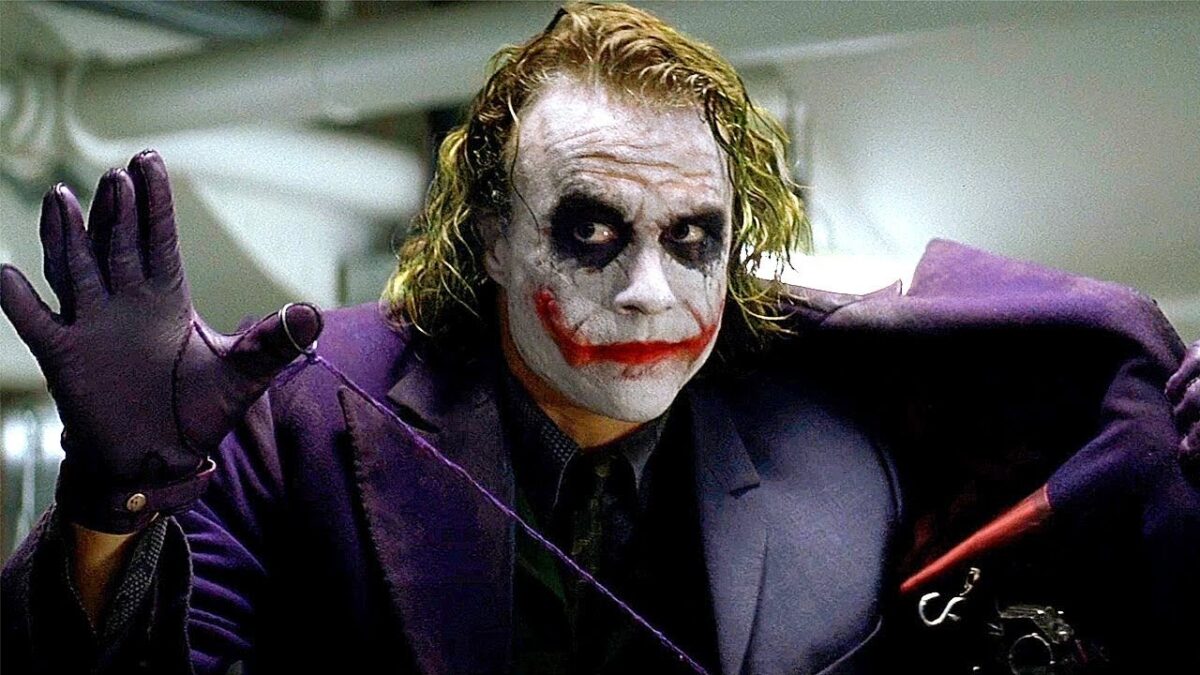
Wait, no word about the obvious parallels with the Patriotic Act and the “War on Terror” that America started after 9-11?